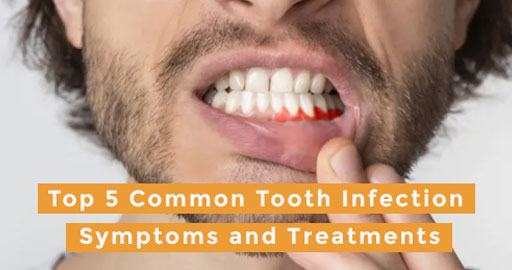
Top 5 Common Tooth Infection Symptoms and Ttreatments
Tooth infections, also known as dental abscesses, can be painful and potentially serious conditions that require prompt attention. These infections typically result from bacteria entering the pulp of the tooth, causing inflammation and often severe discomfort. In this blog, we will discuss the top 5 common tooth infection symptoms and the treatments available to address them.
Symptoms of a Tooth Infection
- Severe Toothache: One of the most common symptoms of a tooth infection is a throbbing and persistent toothache. The pain can range from mild to excruciating and is often aggravated by chewing, hot or cold foods, and even simple activities like talking.
- Swelling of the Face and Gums: Tooth infections can lead to swelling of the face, typically near the infected tooth. The gums around the affected area may also become red and swollen.
- Fever and General Malaise: In more severe cases, a tooth infection can lead to a fever and a general feeling of illness. This is your body’s response to the infection and an indication that it may be spreading.
- Bad Taste and Odor: An unpleasant taste or odor in the mouth can result from the discharge of pus caused by the infection. This may also be accompanied by bad breath.
- Pus Drainage: If the infection progresses, you might notice the presence of pus around the affected tooth or a visible, pimple-like bump on the gums known as a dental abscess.
Treatments for Tooth Infections
- Antibiotics: For less severe tooth infections, your dentist may prescribe antibiotics to eliminate the infection. Antibiotics can reduce the swelling and alleviate some of the pain. However, they are typically a temporary solution and may need to be followed up with further treatment.
- Root Canal Therapy: When the infection has reached the pulp of the tooth, a root canal procedure may be necessary. This involves removing the infected pulp and cleaning and sealing the tooth to prevent further infection. Root canals are highly effective at saving the tooth while eliminating the infection.
- Tooth Extraction: In cases where the tooth is severely damaged and cannot be saved with a root canal, extraction may be the only option. After extraction, your dentist may recommend replacement options such as dental implants or bridges to maintain proper oral function.
- Drainage of Abscess: If there is a visible abscess, your dentist may need to drain it to relieve pain and pressure. This procedure is typically done in conjunction with antibiotics to ensure the infection is treated.
- Pain Management: Regardless of the treatment chosen, pain management is a crucial part of dealing with a tooth infection. Your dentist may recommend over-the-counter pain relievers or prescribe stronger medications to help you manage the discomfort.
Conclusion
Tooth infections are not something to be taken lightly. If you experience any of the common symptoms mentioned above, it’s important to seek dental care promptly. Early intervention can prevent the infection from spreading and potentially save your tooth.
Remember that maintaining good oral hygiene practices, such as regular brushing, flossing, and dental check-ups, can help prevent tooth infections in the first place. If you suspect a tooth infection, don’t hesitate to contact your dentist and get the treatment you need for a healthy, pain-free smile.
Leave a Reply
Leave a Reply
Explore More Similar Posts
Explore More Blogs


Leave a Reply